A BIM-LCA Approach for Estimating the Greenhouse Gas Emissions of Large-Scale Public Buildings: A Case Study
Abstract
1. Introduction
2. Materials and Methods
2.1. Case Project
2.2. Goal and Accounting Scope Definition
2.3. BIM-Based Inventory Analysis
2.4. LCGGE Estimation Model
2.4.1. Estimation of GGE from the Materialization Stage—
2.4.2. Estimation of GGE from the Maintenance and Operation Stage—
2.4.3. Estimation of GGE from the Demolition Stage—
2.5. LCGGE Assessment
2.5.1. GGE from the Materialization Stage—
2.5.2. GGE from the Maintenance and Operation Stage—
2.5.3. GGE from the Demolition Stage—
3. Interpretation of the Results
3.1. GGE from Different Buidling Materials
3.2. GGE in Different Months
3.3. GGE from Different Stages
3.4. Limitations of Proposed Method
4. Conclusions and Recommendations
4.1. Conclusions
- (1)
- The LCGGE of a building can be divided into three stages: the materialization stage, the operation and maintenance stage, and the demolition stage based on the theory. BIM, as an advanced information technology in the construction industry, can help provide the required data for LCA.
- (2)
- During the materialization stage, concrete and steel are the most important source of GGE among all building materials. The reduction of the waste of concrete and steel is valuable for GGE reduction.
- (3)
- For regions with hot summers and warm winters, the GGE of a building in summer is the most throughout out the whole year during the operation and maintenance stage.
- (4)
- For large-scale public buildings, the GGE during the operation and maintenance stage accounts for over 80% of the LCGGE of a building, which is much higher than that of residential buildings. Therefore, the operation and maintenance stage plays the most important role in energy saving and emissions reduction for a large-scale building.
- (5)
- The demolition stage is less important in GGE reduction compared with the other two stages.
4.2. Recommendations
- (1)
- The compatibility of different BIM platforms should be improved in the future.
- (2)
- This paper fails to test the effects of different GGE reduction measures, such as adopting recycled materials or using additional energy-efficient facilities. In the future, studies should focus on seeking the best way to achieve green buildings with the lowest LCGGE.
- (3)
- For developing countries such as China, the urbanization process is less than 50 years old and it is difficult to find the early data regarding building energy consumption that may have been lost. Therefore, we hope to have better data to modify the established energy analysis model in future studies.
Author Contributions
Funding
Acknowledgments
Conflicts of Interest
References
- Ghaffarianhoseini, A.H.; Dahlan, N.D.; Berardi, U.; Ghaffarianhoseini, A.; Makaremi, N.; Ghaffarianhoseini, M. Sustainable energy performances of green buildings: A review of current theories, implementations and challenges. Renew. Sustain. Energy Rev. 2013, 25, 1–17. [Google Scholar] [CrossRef]
- United Nations Environment Programme (UNEP). Buildings and Climate Change: Summary for Decision-Makers; UNEP Sustainable Building and Climate Initiative: Paris, France, 2009; pp. 2–11. [Google Scholar]
- Šujanová, P.; Rychtáriková, M.; Sotto Mayor, T.; Hyder, A. A Healthy, Energy-Efficient and Comfortable Indoor Environment, a Review. Energies 2019, 12, 1414. [Google Scholar] [CrossRef]
- Lai, X.; Liu, J.; Qian, S.; Georgiev, G.; Wu, G. Driving forces for low carbon technology innovation in the building industry: A critical review. Renew. Sustain. Energy Rev. 2017, 74, 299–315. [Google Scholar] [CrossRef]
- Lavy, S.; Dixit, M.K. Literature review on design terror mitigation for facility managers in public access buildings. Facilities 2010, 28, 542–563. [Google Scholar] [CrossRef]
- Feng, Y.P.; Yong, W.; Liu, C.B. Energy-efficiency supervision systems for energy management in large public buildings: Necessary choice for china. Energy Policy 2009, 37, 2060–2065. [Google Scholar]
- He, J.; Yan, Z.F.; Liu, H.J. On the current energy consumption and countermeasures of large public buildings in china. Adv. Mater. Res. 2011, 374–377, 840–842. [Google Scholar] [CrossRef]
- Xu, Z.; Lau, S. Introduction to the building research establishment environmental assessment method (breeam) in UK. New Archit. 2002, 80, 55–58. [Google Scholar]
- Wu, P.; Mao, C.; Wang, J.; Song, Y.; Wang, X. A decade review of the credits obtained by leed v2.2 certified green building projects. Build. Environ. 2016, 102, 167–178. [Google Scholar] [CrossRef]
- Lin, H.Y.; Chen, Z.J.; Ye, L. Interpretation of GB/T50378-2014 national standard green building evaluation standard. Constr. Sci. Technol. 2014, 16, 10–14. (In Chinese) [Google Scholar]
- Li, Y.; Li, Y.; He, B.; Zhao, D. Green building in china: Needs great promotion. Sustain. Cities Soc. 2014, 11, 1–6. [Google Scholar] [CrossRef]
- Spinoza, O.; Buehlmann, U.; Smith, B. Forest certification and green building standards: Overview and use in the U.S. hardwood industry. J. Clean. Prod. 2012, 33, 30–41. [Google Scholar] [CrossRef]
- Zhang, Y.; Wang, J.; Hu, F.; Wang, Y. Comparison of evaluation standards for green building in china, britain, united states. Renew. Sustain. Energy Rev. 2017, 68 Pt P1, 262–271. [Google Scholar] [CrossRef]
- Amiri, A.; Ottelin, J.; Sorvari, J. Are leed-certified buildings energy-efficient in practice? Sustainability 2019, 11, 1672. [Google Scholar] [CrossRef]
- Lee, W.L.; Burnett, J. Benchmarking energy use assessment of hk-beam, breeam and leed. Build. Environ. 2008, 43, 1882–1891. [Google Scholar] [CrossRef]
- Law, C.H.; Yang, J.K.; Jiang, X.Y. Building energy simulation for leed qualification on a commercial building in china. Appl. Mech. Mater. 2012, 193–194, 258–269. [Google Scholar] [CrossRef]
- Jeroen, B. Guinee. Handbook on life cycle assessment operational guide to the iso standards. Int. J. Life Cycle Assess. 2002, 7, 311. [Google Scholar]
- Göran, F.; Michael Tomas, E.; Jeroen, G.; Sangwon, S. Recent developments in life cycle assessment. J. Environ. Manag. 2009, 91, 1–21. [Google Scholar]
- Cabeza, L.F.; Rincón, L.; Vilariño, V.; Pérez, G.; Castell, A. Life cycle assessment (lca) and life cycle energy analysis (lcea) of buildings and the building sector: A review. Renew. Sustain. Energy Rev. 2014, 29, 394–416. [Google Scholar] [CrossRef]
- Agrawal, B.; Tiwari, G.N. Life cycle cost assessment of building integrated photovoltaic thermal (bipvt) systems. Energy Build. 2010, 42, 1472–1481. [Google Scholar] [CrossRef]
- Khasreen, M.; Banfill, P.F.; Menzies, G. Life-cycle assessment and the environmental impact of buildings: A review. Sustainability 2009, 1, 674–701. [Google Scholar] [CrossRef]
- Rowlinson, S.; Collins, R.; Tuuli, M.M.; Jia, Y. Implementation of Building Information Modeling (BIM) in construction: A comparative case study. Aip Conf. Proc. 2010, 1233, 572–577. [Google Scholar]
- Habib, A.; Das, N.G.; Hossain, M.B. Retracted: Case study of carbon emissions from a building’s life cycle based on bim and ecotect. Pak. J. Biol. Sci. 2017, 2017, 193505. [Google Scholar]
- Martin, P. Building information modelling (bim) based energy analysis and response to low carbon construction innovations. Clin. Chem. 2013, 37, 111–112. [Google Scholar]
- Röck, M.; Hollberg, A.; Habert, G.; Passer, A. Lca and bim: Visualization of environmental potentials in building construction at early design stages. Build. Environ. 2018, 140, 153–161. [Google Scholar] [CrossRef]
- Eleftheriadis, S.; Mumovic, D.; Greening, P. Life cycle energy efficiency in building structures: A review of current developments and future outlooks based on bim capabilities. Renew. Sustain. Energy Rev. 2017, 67, 811–825. [Google Scholar] [CrossRef]
- Robert, B. Evaluation of maturity of bim tools across different software platforms. Procedia Eng. 2016, 164, 481–486. [Google Scholar]
- Feng, J.; Zhang, J.P.; Gao, S.P. Chooseing suitable bim software for engineering projects based on the fuzzy neural network evaluation model. Appl. Mech. Mater. 2013, 405–408, 3348–3351. [Google Scholar] [CrossRef]
- Asojo, A.O. An instructional design for building information modeling (bim) and revit in interior design curriculum. Art Des. Commun. High. Educ. 2012, 11, 143–154. [Google Scholar] [CrossRef]
- Ashfaque, A.C.; Rasul, M.G.; Khan, M.M.K. Thermal-comfort analysis and simulation for various low-energy cooling-technologies applied to an office building in a subtropical climate. Appl. Energy 2008, 85, 449–462. [Google Scholar]
- Tullio, R.; Iole, N.; Dario, A.; Domenica, P. Is a self-sufficient building energy efficient? Lesson learned from a case study in mediterranean climate. Appl. Energy 2018, 218, 131–145. [Google Scholar]
- Sartori, I.; Hestnes, A.G. Energy use in the life cycle of conventional and low-energy buildings: A review article. Energy Build. 2007, 39, 249–257. [Google Scholar] [CrossRef]
- Lucchi, E. Simplified assessment method for environmental and energy quality in museum buildings. Energy Build. 2016, 117, 216–229. [Google Scholar] [CrossRef]
- Peng, C. Calculation of a building’s life cycle carbon emissions based on Ecotect and building information modeling. J. Clean. Prod. 2016, 112, 453–465. [Google Scholar] [CrossRef]
- Penman, J.; Gytarsky, M.; Hiraishi, T.; Irving, W.; Krug, T. The National Greenhouse Gas Inventories Programme. In 2006 IPCC Guidelines for National Greenhouse Gas Inventories; Eggleston, H.S., Buendia, L., Miwa, K., Ngara, T., Tanabe, K., Eds.; IGES: Hayama, Japan, 2006. [Google Scholar]
- Xiao, Z.; Jian, G.; Yan, Y. Research of co2 emission of residential buildings in zhejiang province based on life cycle assessment. Adv. Mater. Res. 2012, 461, 255–258. [Google Scholar]
- Hui, J.J.; Wu, Z.W.; Yuan, L.Z.; Jun, B. Life cycle energy consumption and co2 emission of an office building in china. Int. J. Life Cycle Assess. 2012, 17, 105–118. [Google Scholar]
- Zhang, X.L.; Shen, L.Y.; Zhang, L. Life cycle assessment of the air emissions during building construction process: A case study in Hong Kong. Renew. Sustain. Energy Rev. 2013, 17, 160–169. [Google Scholar] [CrossRef]
- Department of Climate Change, National Development and Reform Commission. 2012 Baseline Emission Factors for Regional Power Grids in China. Available online: http://qhs.mee.gov.cn/kzwsqtpf/201812/W020181220585205729251.pdf (accessed on 11 January 2020). (In Chinese)
- Lu, K.; Jiang, X.; Tam, V.W.; Li, M.; Wang, H.; Xia, B.; Chen, Q. Development of a Carbon Emissions Analysis Framework Using Building Information Modeling and Life Cycle Assessment for the Construction of Hospital Projects. Sustainability 2019, 11, 6274. [Google Scholar] [CrossRef]
- Zhang, X.; Wang, F. Life-cycle assessment and control measures for carbon emissions of typical buildings in China. Build. Environ. 2015, 86, 89–97. [Google Scholar] [CrossRef]
- Zhang, Y.; Zheng, X.; Zhang, H.; Chen, G.; Wang, X. Carbon emission analysis of a residential building in China through life cycle assessment. Front. Environ. Sci. Eng. 2016, 10, 150–158. [Google Scholar] [CrossRef]
- Li, D.; Cui, P.; Lu, Y. Development of an automated estimator of life-cycle carbon emissions for residential buildings: A case study in Nanjing, China. Habitat Int. 2016, 57, 154–163. [Google Scholar] [CrossRef]
- Lucchi, E. Review of preventive conservation in museum buildings. J. Cult. Herit. 2018, 29, 180–193. [Google Scholar] [CrossRef]
- Najjar, M.; Figueiredo, K.; Hammad, A.W.; Haddad, A. Integrated optimization with building information modeling and life cycle assessment for generating energy efficient buildings. Appl. Energy 2019, 250, 1366–1382. [Google Scholar] [CrossRef]
- Hollberg, A.; Genova, G.; Habert, G. Evaluation of BIM-based LCA results for building design. Autom. Constr. 2020, 109, 102972. [Google Scholar] [CrossRef]
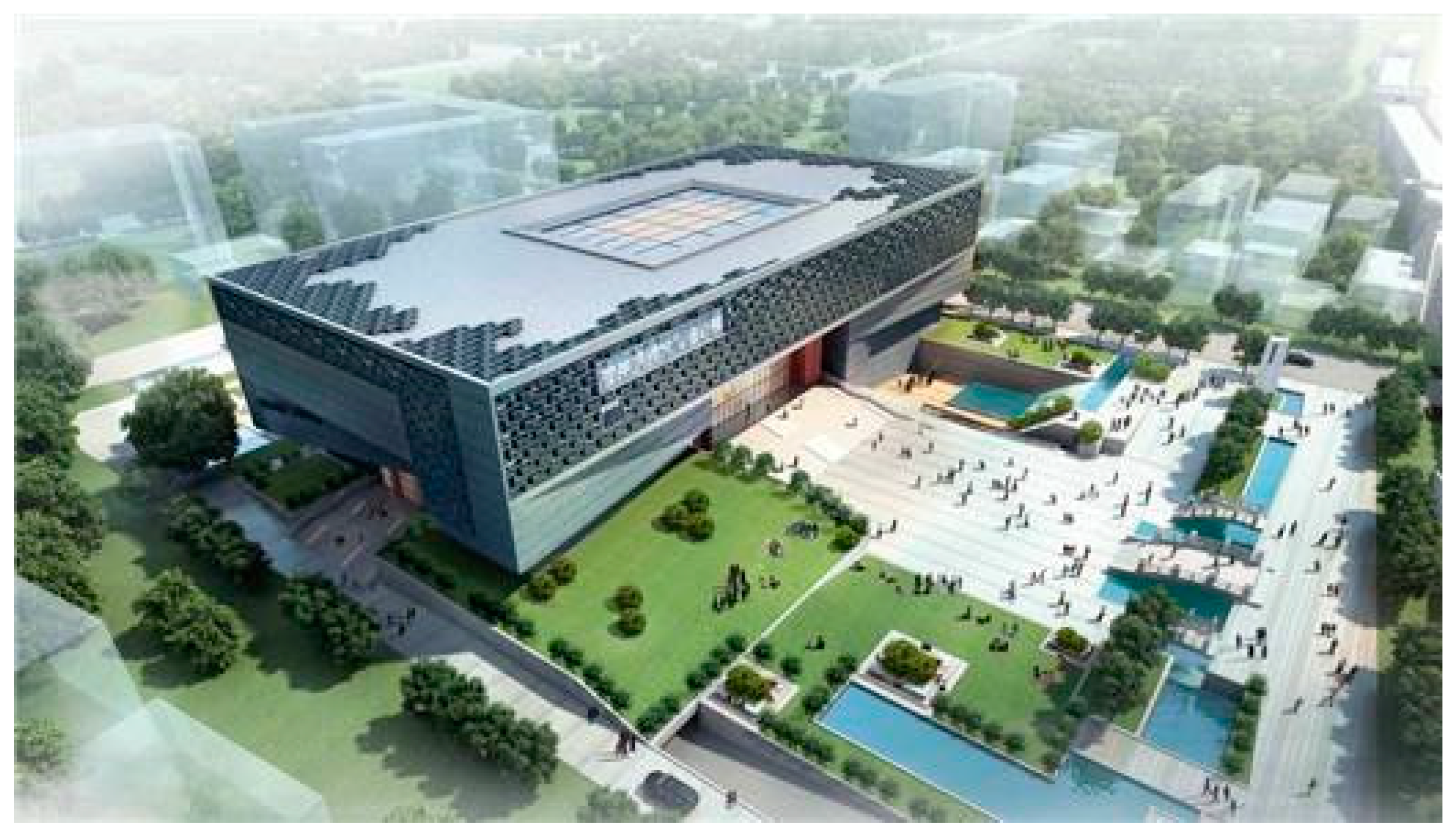
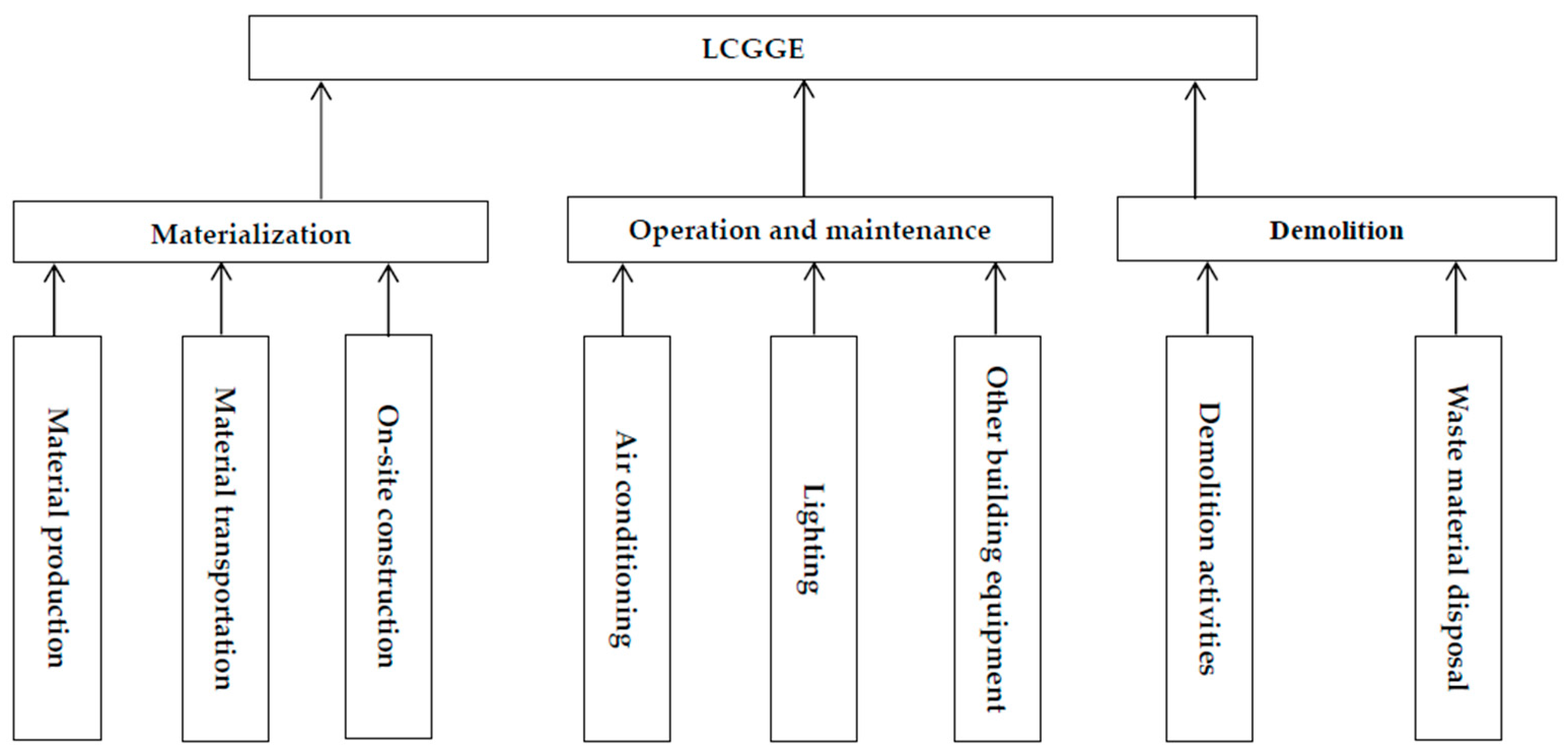
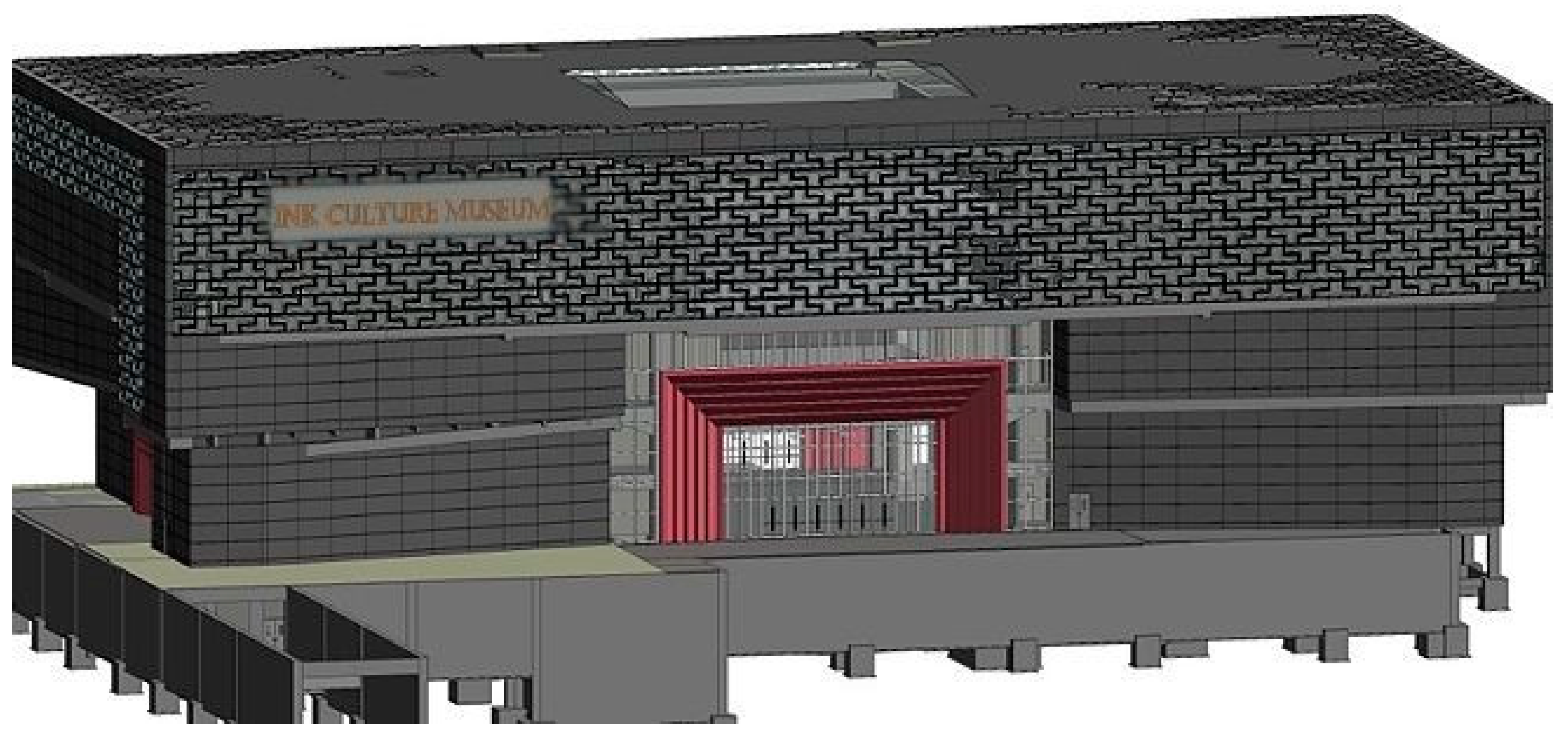
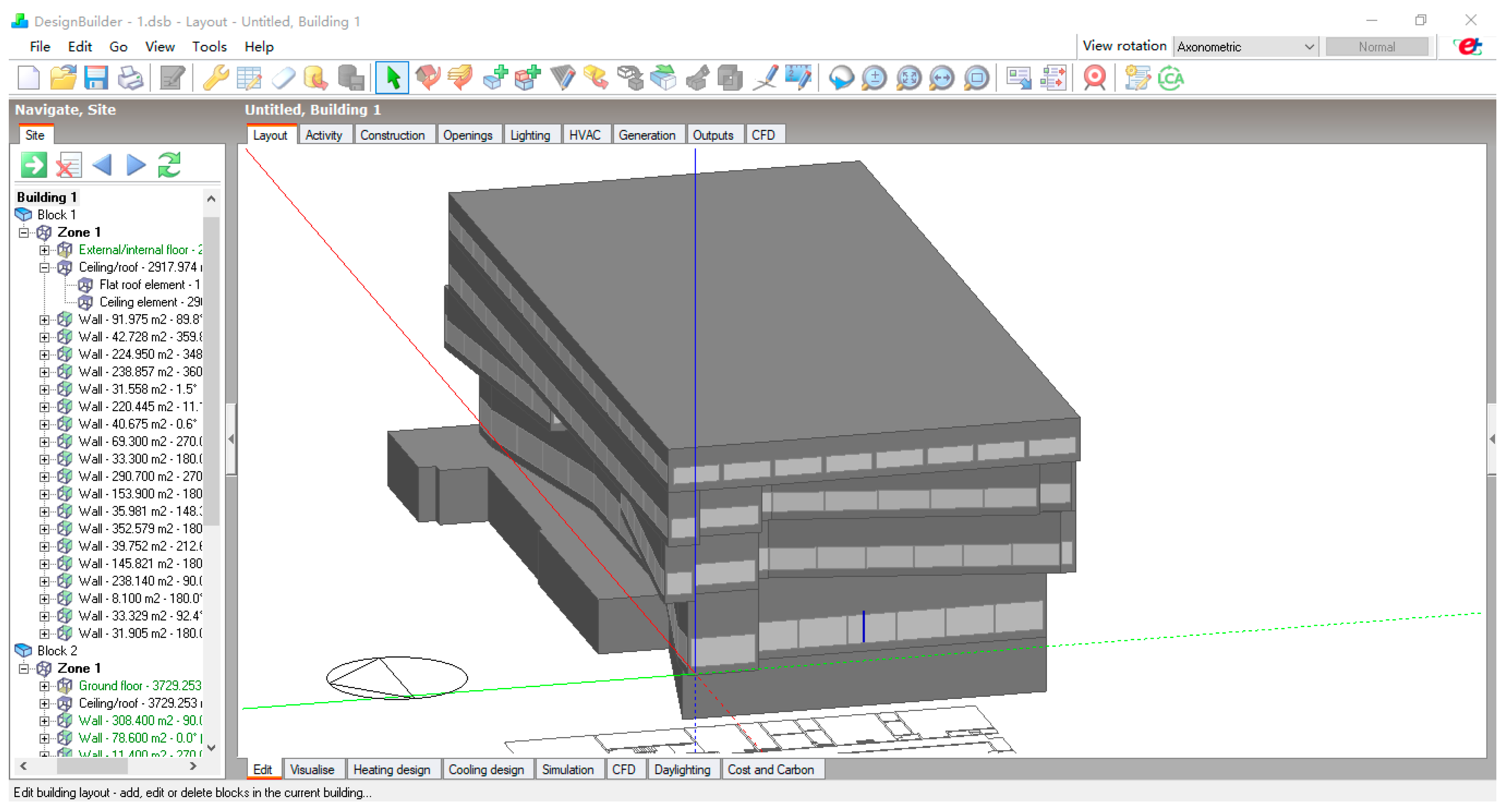
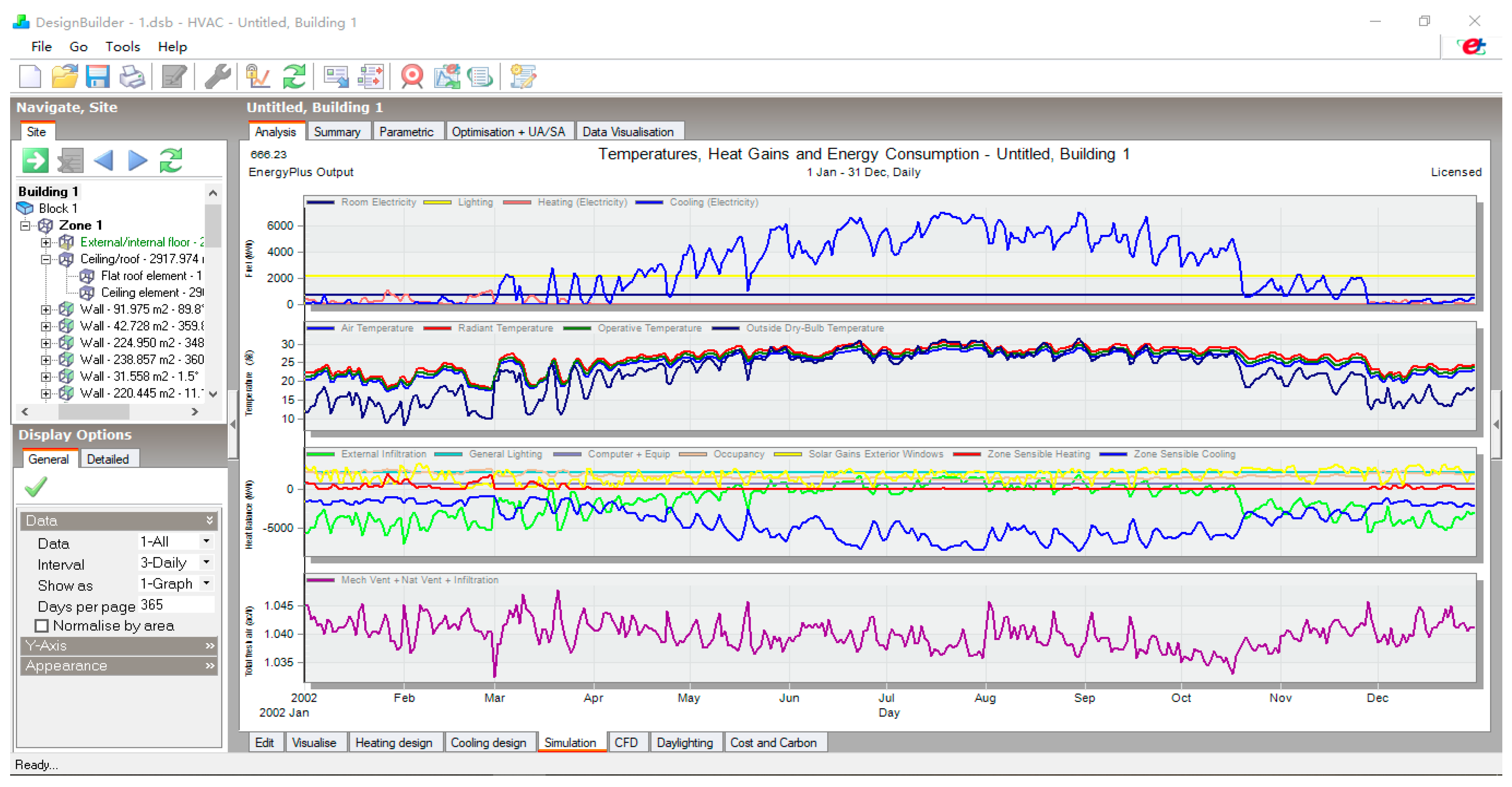
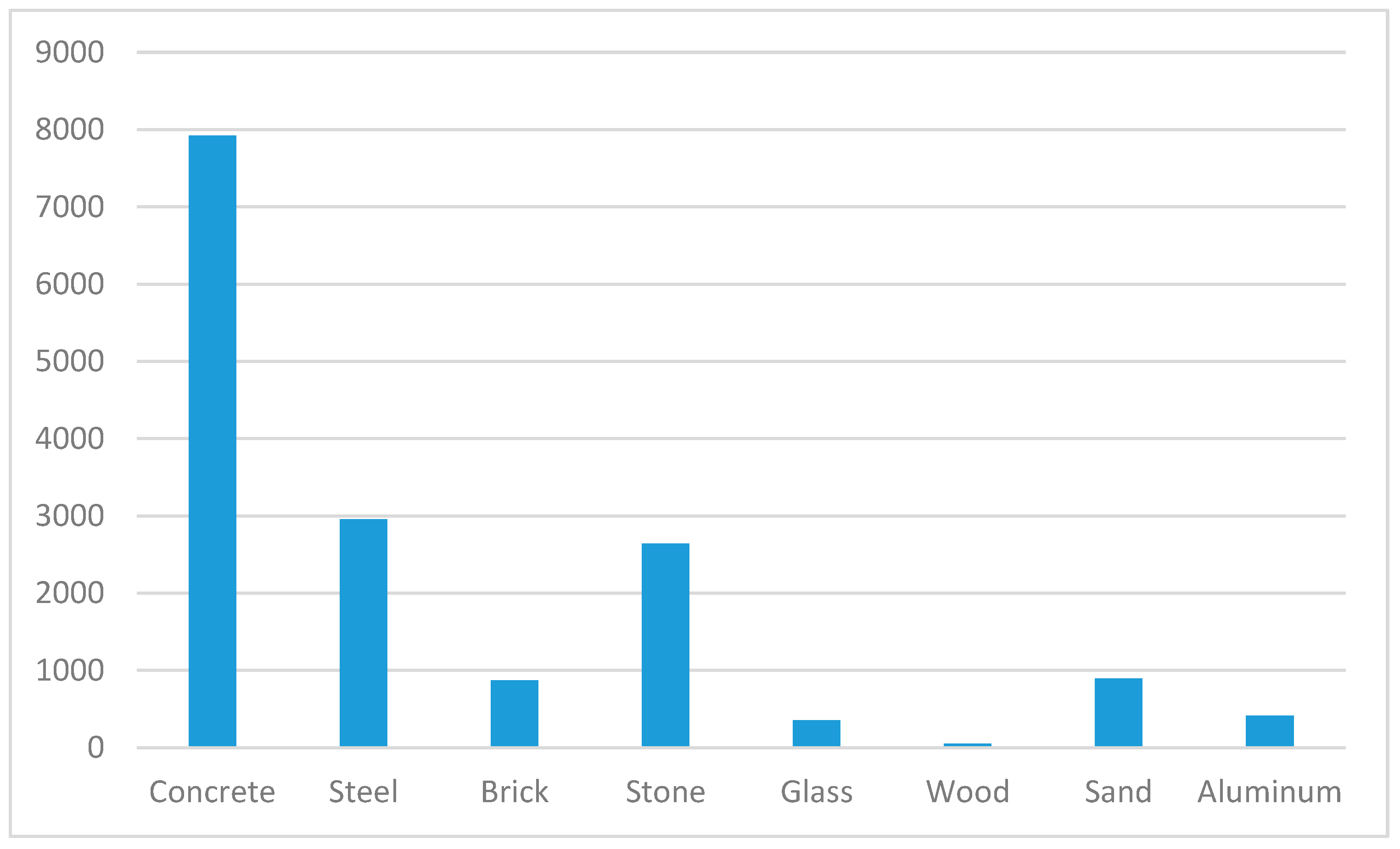
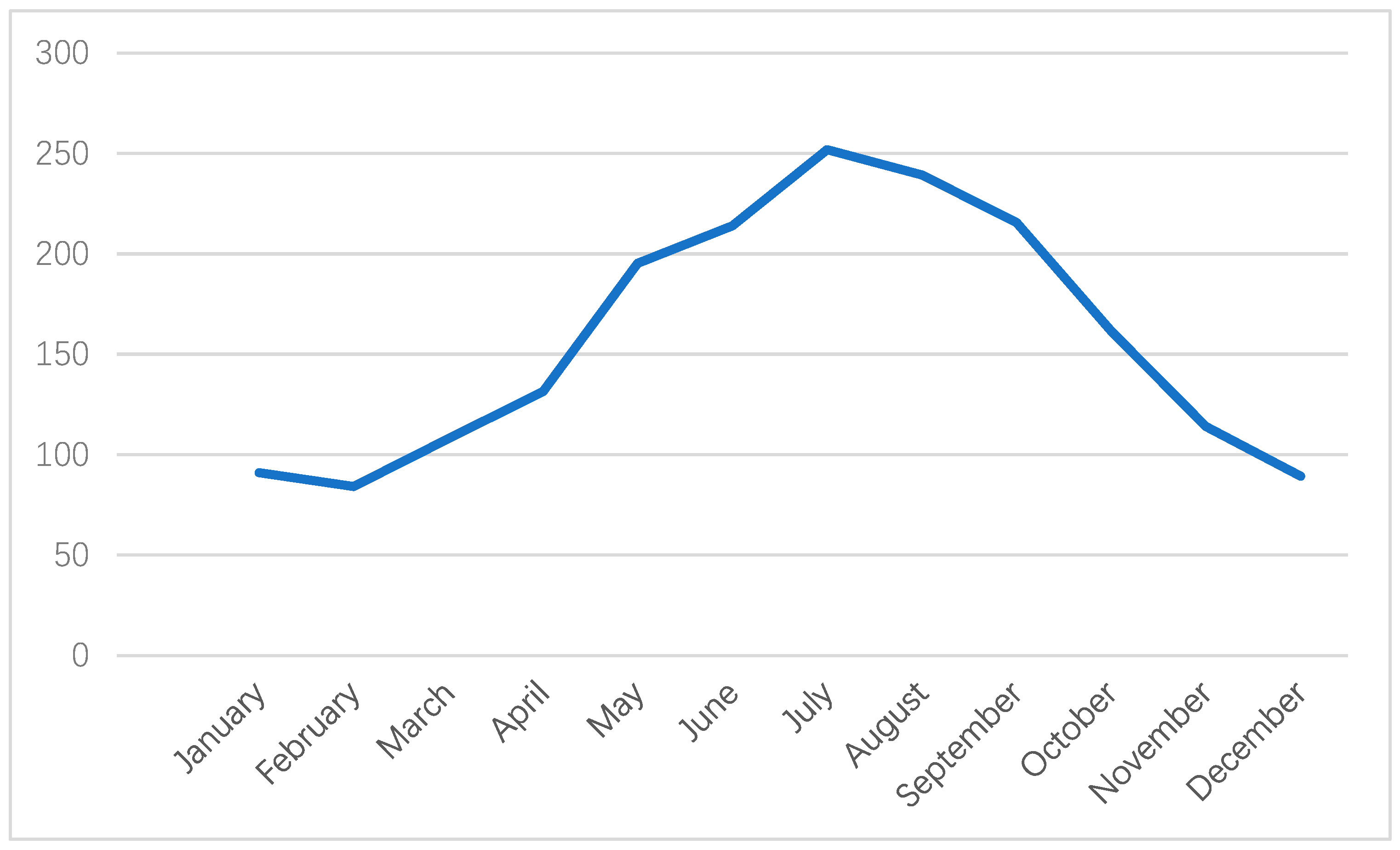

| Materials | Quantity (t) |
|---|---|
| Concrete | 32,730.26 |
| Steel | 1339.34 |
| Brick | 4371.12 |
| Stone | 1134.18 |
| Glass | 252.57 |
| Wood | 267.84 |
| Sand | 991.82 |
| Aluminum | 294.05 |
| Total | 41,381.18 |
| Building Materials | Energy Consumption (KJ/kg) | GGE(t/t) |
|---|---|---|
| Concrete | 1247.74 | 0.2420 |
| Brick | 2000 | 0.2 |
| Stone | 12,943 | 2.33 |
| Steel | 33,906 | 2.208 |
| Glass | 16,000 | 1.4 |
| Wood | 1800 | 0.2 |
| Sand | 4000 | 0.9 |
| Aluminum | 12,964 | 1.407 |
| Designation | Temperature |
|---|---|
| Outdoor dry bulb temperature in summer | 33.5 °C |
| Outdoor wet bulb temperature in summer | 27.7 °C |
| Outdoor dry bulb temperature in winter | 5 °C |
| Outdoor wet bulb temperature in winter | 1.3 °C |
| Building Materials | Amount (t) | Carbon Emission Factor (t/t) | GGE (t) |
|---|---|---|---|
| Concrete | 32,730.26 | 0.2420 | 7920.72 |
| Steel | 1339.34 | 2.208 | 2957.26 |
| Brick | 4371.12 | 0.2 | 874.22 |
| Stone | 1134.18 | 2.33 | 2642.64 |
| Glass | 252.57 | 1.4 | 353.60 |
| Wood | 267.84 | 0.2 | 53.57 |
| Sand | 991.82 | 0.9 | 892.64 |
| Aluminum | 294.05 | 1.407 | 413.73 |
| Date/Time | Air Conditioning | Lighting (kWh) | Other Equipment (kWh) | Total (kWh) | |
|---|---|---|---|---|---|
| Heating (kWh) | Cooling (kWh) | ||||
| January | 8215.37 | 1958.22 | 66,555.84 | 20,653.02 | 97,382.45 |
| February | 9029.39 | 2265.59 | 60,114.95 | 18,654.34 | 90,064.27 |
| March | 3585.63 | 24,788.93 | 66,555.84 | 20,653.02 | 115,583.40 |
| April | 0 | 56,240.30 | 64,408.88 | 19,986.79 | 140,636.00 |
| May | 0 | 121,786.90 | 66,555.84 | 20,653.02 | 208,995.80 |
| June | 0 | 144,530.70 | 64,408.88 | 19,986.79 | 228,926.40 |
| July | 0 | 182,396.20 | 66,555.84 | 20,653.02 | 269,605.10 |
| August | 0 | 168,889.80 | 66,555.84 | 20,653.02 | 256,098.70 |
| September | 0 | 146,424.70 | 64,408.88 | 19,986.79 | 230,820.40 |
| October | 0 | 85,750.89 | 66,555.84 | 20,653.02 | 172,959.80 |
| November | 312.25 | 37,371.48 | 64,408.88 | 19,986.79 | 122,079.40 |
| December | 2945.42 | 5365.85 | 66,555.84 | 20,653.02 | 95,520.13 |
© 2020 by the authors. Licensee MDPI, Basel, Switzerland. This article is an open access article distributed under the terms and conditions of the Creative Commons Attribution (CC BY) license (http://creativecommons.org/licenses/by/4.0/).
Share and Cite
Cheng, B.; Li, J.; Tam, V.W.Y.; Yang, M.; Chen, D. A BIM-LCA Approach for Estimating the Greenhouse Gas Emissions of Large-Scale Public Buildings: A Case Study. Sustainability 2020, 12, 685. https://doi.org/10.3390/su12020685
Cheng B, Li J, Tam VWY, Yang M, Chen D. A BIM-LCA Approach for Estimating the Greenhouse Gas Emissions of Large-Scale Public Buildings: A Case Study. Sustainability. 2020; 12(2):685. https://doi.org/10.3390/su12020685
Chicago/Turabian StyleCheng, Baoquan, Jingwei Li, Vivian W. Y. Tam, Ming Yang, and Dong Chen. 2020. "A BIM-LCA Approach for Estimating the Greenhouse Gas Emissions of Large-Scale Public Buildings: A Case Study" Sustainability 12, no. 2: 685. https://doi.org/10.3390/su12020685
APA StyleCheng, B., Li, J., Tam, V. W. Y., Yang, M., & Chen, D. (2020). A BIM-LCA Approach for Estimating the Greenhouse Gas Emissions of Large-Scale Public Buildings: A Case Study. Sustainability, 12(2), 685. https://doi.org/10.3390/su12020685





